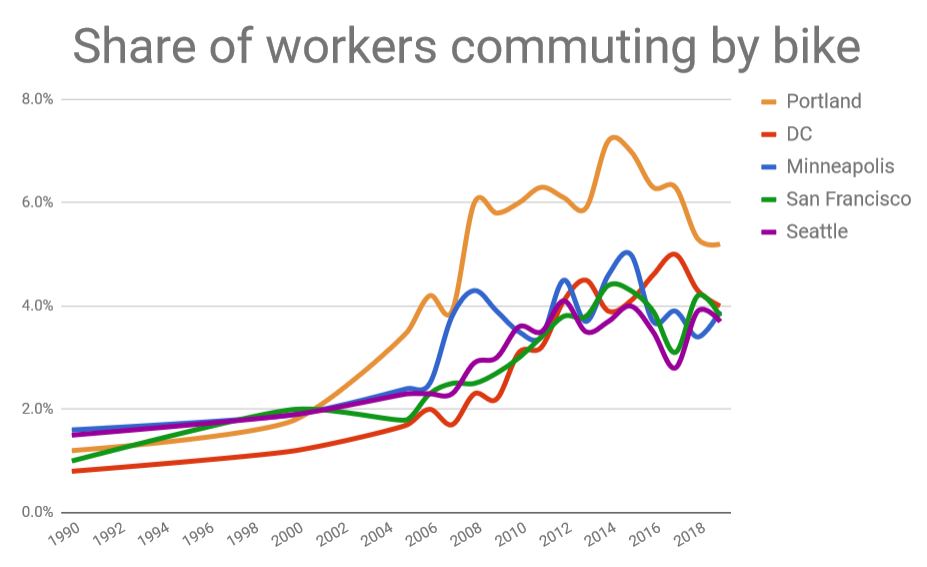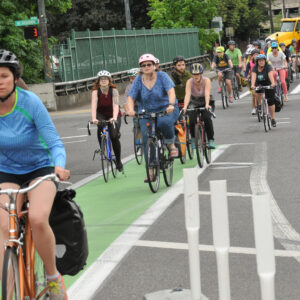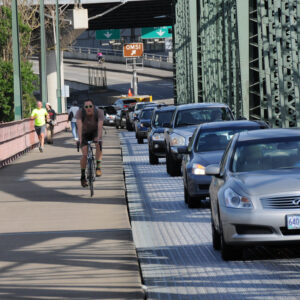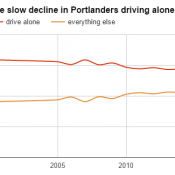This is a guest post from former BikePortland news editor Michael Andersen. He now writes about housing and transportation for Sightline Insitute, a regional sustainability think tank.
In its final snapshot of pre-pandemic travel habits, U.S. Census surveys found that 2019 was another year with little growth in bike commuting, in Portland or elsewhere.
Nobody knows, of course, exactly how the COVID pandemic will change all this. It’s just certain that it has.
Portland’s bike commuting rate was 5.2 percent, the Census found in its annual compilation of surveys collected throughout the previous calendar year, down from an average of 6.3 percent over the previous five years and the lowest single-year estimate since 2007. The new finding served as a likely confirmation of last year’s discouraging indication that Portland’s mid-decade boomlet of bike commuting seemed to have receded.
The ratio refers to the percentage of Portland residents who headed to jobs primarily by bike over the previous week.
Across the Portland metro area, the estimated bike-commuting rate was 1.9 percent, down from an average of 2.3 percent over the previous five years. The national estimate, too, was flat to down: 0.5 percent from 0.6 percent.
Other large U.S. cities with significant bike commuting were also flat or on the low end of their five-year averages.
Some Oregonians might be particularly interested in one spot of bright news: After several years of lagging seriously, Eugene’s bike commuting estimate ticked back up to 6 percent. Oregon’s third-largest city can once again claim to have more bike commuting than its largest.
Unfortunately, even that rise is well within Eugene’s larger error margin.
It’s still a complete mystery how the pandemic might change commutes

(Photo: J. Maus/BikePortland)
These 2019 estimates aren’t a big surprise.
Portland gas prices spent most of 2019 above $3 a gallon, but never flirted with $4 as they had after the recession. Despite regular incremental improvements, momentous decisions in 2018 like the Central City in Motion plan and a few major projects in the pipeline, little new infrastructure has actually hit the ground on Portland’s key commuting routes in years. In fact, one significant bike commuting pinchpoint, the Burnside Bridge, spent almost all of 2018 and 2019 pretty bad to bike on before getting an upgrade as 2020 began.
Advertisement
And speaking of 2020…
Nobody knows, of course, exactly how the COVID pandemic will change all this. It’s just certain that it has.
Even in 2019, Portland’s work-from-home rate hit an estimated 9.1 percent, another all-time high and one of the nation’s highest rates for a major city. (In case you were wondering, the exact question is: “How did this person usually get to work LAST WEEK? Mark (X) ONE box for the method of transportation used for most of the distance.”)
That work-from-home figure will surely soar in 2020 and 2021, perhaps especially for one of Portland’s core biking populations: people who work downtown. Meanwhile, the collapse in transit ridership and the boom in bike sales are introducing many more people to bikes as both recreation and transportation. And for many victims of this chaotic economy, bikes are of course a way to save money.
It’s my own belief that infrastructure investments alone don’t lead to much change in commuting habits until some sort of external force gives many people a reason to reconsider their daily routines at once. This scrambling of transportation trends can come from a gas price shift, a global pandemic, maybe even whatever other catastrophes might await us next.
— Michael Andersen: @andersem on Twitter.
— Get our headlines delivered to your inbox.
— Support this independent community media outlet with a one-time contribution or monthly subscription.








Thanks for reading.
BikePortland has served this community with independent community journalism since 2005. We rely on subscriptions from readers like you to survive. Your financial support is vital in keeping this valuable resource alive and well.
Please subscribe today to strengthen and expand our work.
I normally bike to work from mid-spring to mid-fall, from N Portland to Clackamas. This year was a no go as I couldn’t shower at my gym before work.
my employer (a rather large one on Swan Island) locked up the on-site locker rooms and showers and done other things to basically discourage any bike commuting at all.
Wow, that is horrible. My large employer out in Gresham kept the locker rooms open, but closed the on-site gym. It seems like a really low risk activity, especially considering how few use it.
I just wrote a similar post on the local numbers here in Madison: https://www.madisonbikes.org/2020/09/biking-numbers-in-madison-not-so-great/ It’s quite depressing from an advocate’s perspective. My overall take is that for medium and large-size cities there’s a threshold somewhere in the 5-8% mode share range that, as you said, Michael, is hard to overcome with just adding some bike infra here and there. National trends and/or more drastic measures at the local level are probably what is needed.
Yeah, right now doesn’t feel like a good time for making forward progress on much of anything, does it? Hopefully by (ahem) January things will start looking up, and we can get to work fixing what’s broken in our society, much of which has been exposed by the pandemic. 20/20: the year of seeing clearly.
January is when something REALLY BAD happens. Stop fooling yourself.
Is that what Q said?
I don’t think I’m fooling myself; I said “hopefully”, not “surely.”
I am well aware of some really, really, very bad things that may happen next year. I’m even aware of certain people who want that outcome. If it comes to pass it could make 2020 look like a pleasant dream.
But as for optimism, you can’t reach a goal you don’t aim for.
I do have to admit that tonight’s debate slices another layer off of that optimism. Wow.
Sadly its still ‘too cheap” to drive a lot and everyday (and not just when one “has to”)…from fuel to other things a city can control, like parking and land use decisions…preCOVID19.
Wow, Portland bike commuting is now thirteen years into its plateau. You’re finally building some protected infrastructure, e-bikes are now approaching mainstream, there’s more awareness of our climate catastrophe, but … no growth. Of course some of this is because many potential middle and lower-income bike commuters are being displaced further from the bikeable core, but all the top biking cities have followed similar curves, plateauing since the late ’00s.
Two words explain it all: cheap gas.
The never-ending battle for second place continues, with my current home of Minneapolis in the usual virtual tie with the usual contenders of DC, Seattle and SF. A whole percentage point below Portland. Some things never seem to change.
Here in Eugene we wish we had had a plateau. Bike commuting was going along swimmingly until 2012 when it began a descent that hopefully reversed this year. (We were on track to get to 0% in 2024 from nearly 9% in 2012.)
When bike commuting was plotted against local gas prices over the years, there was no correlation. There’s a lot more going on than simple cost of fuel: We have a city transportation staff who stress the dangers of cycling, a police department that stopped doing traffic enforcement when an officer was killed during a traffic stop right before the decline, continuously added free parking for cars and lots of other pro-driving actions. Hopefully we can get a sea change in transportation before the actual sea inundates us.
I don’t agree with your analysis: I don’t think cycling is propelled by expensive gas, I think it’s more like fashion that follows some sort of ethereal “mindshare”. Cycling for transportation is just not trendy at the moment.
I think you’re right, but also that gas prices play a major role in that fashionability.
It’s ~20% below the plateau and almost 30% below the peak. 20% fewer Portlanders cycle to work than during the 2014 peak. No matter how much one bargains with reality these are really awful numbers.
As unfettered housing speculation continues to burn away the last vestiges of affordable working class housing in this city, I expect this decline to accelerate. Given that so many cycling advocates are unapologetic boosters of gentrification, I can’t help but feel a little schadenfreude.
As for the pandemic’s effect on the stats, I wouldn’t get my hopes up. Most of this year’s bike boom has been in recreational riding, not captured by the question “how did you usually get to work last week?” I know that commuting overall is way down, reducing the denominator, but the numerator will drop too. Did this spring’s transit restrictions and empty roads encourage more of the few who still commuted to get in their cars? Or maybe the opposite: I know in my case, I found myself spending a lot of time on roads that used to be too busy for me to dare ride on.
That feeling of the roads being safer continued well into early summer, even as traffic volumes crept back up. In the weeks after George Floyd’s execution here in Minneapolis, everyone on the streets – cyclists, marchers, walkers, drivers, Black, Indigenous, white – was SUPER respectful of each other. There was definitely a “we’re-all-in-this-together” vibe.
But now, the fraying of the social fabric is ominously palpable on the roads. Sometime in July or August, a switch seems to have to have flipped inside a few drivers’ heads. In the last few weeks I’ve been harassed multiple times by bearded white guys driving work vans or pickups. Always while minding my own business in the bike lane, within a mile of my home. In one case the guy actually came at me in the bike lane, and I had to take evasive action. I’ve also had to wash a guy’s possibly COVID-infested mucus/spit off my arm. Eccchhh. I’m now changing my riding patterns to avoid busy streets, even those with (unprotected) bike lanes. I guess with the overall spike in higher-profile crimes, the sociopaths on the road feel they can get away with anything. To their credit, and contrary to the narrative that they’re too busy to deal with anything but the most serious crimes, MPD took it seriously when I reported it.
Are you guys experiencing the same thing in Portland? I haven’t read any comments about it here at BP, but I’m wondering if the longtime low-level hostility towards cyclists of many Oregon drivers is now becoming less veiled?
“Whom the gods would destroy they first make mad.”from a poem by Longfellow.
I left southrn O a couple weeks before my towns affordable housing got torched. Everyone laughed at me when I tried to warn them. Im in Reno. I get yelled at, swerved at and feel the tension in every driver not totally absorbed in their phone. Everyone knows something REALLY BAD is coming in January and denial brings on tension and aggression.
So go on hoping for the best. Get out of Portland and SOON.
I agree that like small furry forest animals humans can tell when something bad is coming, and act hostile and aggressive as a result. But I don’t really agree that going somewhere else than Portland will make things any better. I think you will find that water starved desert towns, hurricane torn swamplands, gun crazy hillbilly burgs and Potemkin resort towns will not fare any better when TSHTF.
I got out 6 years ago. I’m speaking of a change which has happened on the roads here in Minnesota, and wondering if other BP regulars are feeling it in OR, too.
So are you saying things are worse in Reno than Portland? Or you can’t tell, because more than one variable changed around the same time you moved?
Drivers here in Greensboro NC are noticeably worse now than they were a year ago as well, but I still feel safer biking here than I ever did when I lived in Portland, even as our infrastructure here is spotty and not at all connected. I left Portland about 5 years ago.
Rant: I gave up most of my bike commuting. I’m glad I did, even though I think bicycles are incredibly fun, efficient, world-changing machines.
Taking the bus or Max is much less stressful than having to be constantly alert for careless or aggressive drivers, or trying to follow some poorly-signed, poorly-lit, zig-zag greenway at night, or wondering when the bike lane is going to end (see Glisan or Killingsworth) and dump you without warning into a busy, four-lane road.
I don’t think it’s too much to ask for the slightest modicum of protected bike lane on the major thoroughfares of this city, such as Sandy or Hawthorne or Powell. Despite being actively hostile to bikes, I end up having to ride on them anyway because so many of our businesses are located on those roads.
And does anyone think that the piecemeal, wildly inconsistent smatterings of “infrastructure investment”, such as the bike crossing at NE 37th and Prescott, have convinced anyone that they should be riding a bike instead of driving a car?
I wonder how many people were like me, eager to commute by bike in America’s Bike Capitol, but whose determination was worn down by frustration after frustration.
Yes, it will be interesting to see how the rash of “pandemic drivers” that treat our public roads [and vulnerable roadway users] like a scene out of “Walking Dead” will further reduce the last 20 year trend adoption of multimodal trips due to injuries, threats of vehicular violence etc.
The long term trend of more work from home + lack of peak hour traffic volumes + more use of cycling within residential districts (vs commuting) will require the Fed (and State DOTs) to rethink how they measure mobility ‘need’ and “success” for planning the next generation of facilities for the TIP.
I agree. Imagine if other forms of transit were subject to the sub-standards of our bike infrastructure. It’d be akin to riding the Max and having to detrain every so often to cross the freeway on foot to continue the journey. Or occasionally, feral pigs are released in to the trains, cuz, y’know, that’s just what it’s like to commute by train!
Or a paved freeway with dirt track intersections that crosses at gravel signalized intersections, with the cross-traffic roadway given 10-minute freeflow between each light change, Soviet-style.
We’re talking about a city transportation bureau that refuses to provide hard infrastructure on “greenways” that ensure motorist don’t use them as cut throughs.
I’m not convinced PBOT wants or cares about people biking/scooting.
37th and Prescott isn’t that bad, but I often cross Prescott at 39th, 40th, or 41st because it feels lower stress with the sightlines. Just watch out for Skidmore at 38th and 40th — no stop signs for anyone. Yikes!
I don’t get it. I have been commuting by bicycle for twenty-five years in Portland. Other than device addicts and garbage it’s never been a problem. I would never get back on the bus.
The graph pictured at the top of the article doesn’t represent what I’m seeing on the trails and roads in east county. In fact, in the past 5 years, I’ve seen a large surge in bike commuting aided in part by e-bikes. This makes me suspect that bike commuting overall has increased but simply not enough to match the inflow of people into the metro area who commute by other means.
As a former mid-level Census manager, I take these statistics with a large grain of salt. The Census maintains a very small database of citizens between the ‘big census’. It is so small, that its statistical accuracy is close to zero.
Yeah, people need to realize that these number have HUGE margins of error which make it almost meaningless. We need to stop relying on the census and start doing travel surveys ourselves.
2014 — 7.2 ± 0.9
2015 — 7 ± 0.7
2019 — 5.2 ± 0.6
I honestly think we need to stop caring so much about the commute rate. What really matters is the mode share for all trips. Commuting accounts for a pretty small percentage of vehicle miles travelled. Think about how much people drive for daily errands, dropping people off various places (school, daycare, activities), visiting friends and family, going out of town, etc. Those trips dwarf the daily commute, and should be the focus for reducing carbon emissions.
I think the bike rate would be much higher if you look at all trips, and the highest growth potential is from non-work trips. After all, many people either choose to live fairly far from work, or they have no choice and can only afford to live far from work. In those cases, driving or maybe taking transit may be the only practical options for the work trip. But if they rode their bike for most non-work trips, that would be a net positive. And as long as they have shops and other destinations within biking distance (a distance expanded with e-bikes), there is good potential for switching away from driving.
I totally agree with this. The difficulty, I suspect, is that counting all trips is much more difficult than only counting commute trips. What constitutes a trip? How accurately can you recall and report all your trips? Do you weigh all trips the same, regardless of length or purpose? Does your evening stroll around the neighborhood count as a trip? And so on.
Commute trips are much cleaner from a data perspective.
Nice try but the city’s bike counts show an even steeper decline.
Since we plateaued 13 years ago, two things not being mentioned: people aging out of bike commuting and the influx of new residents may not have the passion for bike commuting. Our demographics in Portland have changed. Our economy has also changed and the new workers coming to take jobs in the tech sector may not care as much about personal fitness, city livability, and the environment as we wish they would.
I completely disagree with his ‘belief’ that we need some mysterious external force to bump the bike commutes higher. Since we haven’t built completely separate protected bike lanes and protected ‘wrap around’ services to victims of #visionzero (ie te cops don’t care if we get hit, what if the drivers were treated like a DUI?) .
Build it and they will come is still a hopeful possibility in my mind. We need to build protected bike lanes and these numbers absolutely will go up. Michael is not a formally trained economist but he plays one in housing and transport journalism.
Regressive gas tax advocacy doesn’t count for much these days in terms of bumping up bike numbers. But the Beckys on Bikes in streets with no Trust are known to obscure tax votes with advocacy.
Random Question… Is there any way to find out how many people ride bikes in Portland as of today?